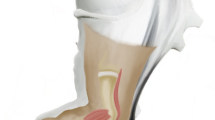Abstract
Shin splints, an exercise-induced form of lower leg pain, is a common complaint among athletes. Considered an overuse injury that compromises the dense and tough fascial attachments of the tibialis posterior and/or tibialis anterior muscles from the tibia, it responds well to a multiphase treatment plan that incorporates plyometric strengthening and conditioning exercises. Plyometrics may be safely introduced as early as the third or functional phase of recovery. A progressive plyometric program that emphasizes a gradual development of eccentric stress loading to the musculoskeletal components of the deep posterior and anterior muscle compartments of the lower leg is described.
Similar content being viewed by others
References and Recommended Reading
Thacker SB, Gilcrest J, Stroup DF, et al.: The prevention of shin splints in sports: a systematic review of literature. Med Sci Sports Exerc 2002, 34:32–40.The authors provide a comprehensive review of the literature as it relates to the prevention of shin splints.
Orava S, Puranen J: Athletes’ leg pains. Brit J Sports Med 1979, 13:92–97.
Andrish JT, Bergfeld JA, Walheim J: A prospective study on the management of shin splints. J Bone Joint Surg 1974, 56A:1697–1700.
Devereaux MD, Lachmann SM: Athletes attending a sports injury clinic: a review. Br J Sports Med 1983, 17:137–142.
Gudas CJ: Patterns of lower-extremity injury in 224 runners. Compr Ther 1980, 6:50–59.
James SL, Bates BT, Osternig LR: Injuries to runners. Am J Sports Med 1978, 6:40–50.
Lysholm J, Wiklander J: Injuries in runners. Am J Sports Med 1987, 15:168–171.
Maughan RJ, Miller JDB: Incidence of training-related injuries among marathon runners. Br J Sports Med 1983, 17:162–165.
Krissoff WB, Ferris WD: Runners’ injuries. Physician Sportsmed 1979, 7:55–64.
Watson MD, Dimartino PP: Incidence of injuries in high school track and field athletes and its relation to performance ability. Am J Sports Med 1987, 15:251–254.
Batt ME: Shin splints - a review of terminology. Clin J Sports Med 1995, 5:53–57.
Washington EL: Musculoskeletal injuries in theatrical dancers: site frequency, severity. Am J Sports Med 1978, 6:75–98.
Heir T: Musculoskeletal injuries in officer training: oneyear follow-up. Mil Med 1998, 163:229–233.
Hutchins CP: Explanation of spike soreness in runners. Am Phys Ed Rev 1913, 18:31–35.
American Medical Association, Committee on the medical aspects of sports, Subcommittee on classification of sports injuries. Standard Nomenclature of Athletic Injuries. Chicago: American Medical Association; 1966:126.
Bouché RT: Exercise induced leg pain. In Sports Medicine of the Lower Extremity, edn 2. Edited by Subotnick SI.New York: Churchill Livingstone; 1999:277–280.
Fredericson M, Bergman AG, Hoffman KL, et al.: Tibial stress reaction in runners - correlation of clinical symptoms and scintigraphy with a new magnetic resonance imaging grading system. Amer J Sports Med 1995, 23:472.
Hislop M, Tierney P: Anatomical variations within the deep posterior compartment of the leg and important critical consequences. J Sci Med Sport 2004, 7:392–399.
Wilson GJ, Wood GA, Elliott BC: Optimal stiffness of series elastic component in a stretch-shorten cycle activity. J Appl Physiol 1991, 70:825–833.
Asmussen R, Bonde-Peterson F: Apparent efficiency and storage of elastic energy in human muscles during exercise. Acta Physiol Scand 1974, 92:537–545.
Cavagna G: Storage and utilization of elastic energy in skeletal muscle. Exerc Sports Sci Rev 1977, 5:89–129.
Holcomb WR, Lander JE, Ryttland RM, Wilson GD: The effectiveness of modified plyometric program on power and the vertical jump. J Strength Cond Res 1996, 10:89–92.
Spurrs RW, Murphy AJ and Watsford ML: The effect of plyometric training on distance running performance. Eur J Appl Physiol 2003, 89:1–7.The authors provide experimental data that support the association of musculotendinous stiffness with running economy.
Robinson LE, Devor ST, Merrick MA, Buckworth J: The effects of land vs. aquatic plyometrics on power, torque, velocity, and muscle soreness in women. J Strength Cond Res 2004, 18:84–91.The authors provide experimental evidence that supports the concept that aquatic plyometrics can provide the same performance enhancement benefits as a land-based plyometric training program.
Martel GF, Harmer ML, Logan JM, Parker CB: Aquatic plyometric training increases vertical jump in female volleyball players. Med Sci Sports Exerc 2005, 37:1814–1819.
Clutch D, Wilton B, McGown M, Byrce GR: The effect of depth jumps and weight training on leg strength and vertical jump. Res Q Exerc Sport 1983, 54:5–10.
Brown ME, Mayhew JL, Boleach LW: Effects of plyometric training on vertical jump performance in high school basketball players. J Sports Med Phys Fitness 1986, 26:1–4.
Author information
Authors and Affiliations
Corresponding author
Rights and permissions
About this article
Cite this article
Herring, K.M. A plyometric training model used to augment rehabilitation from tibial fasciitis. Curr Sports Med Rep 5, 147–154 (2006). https://doi.org/10.1007/s11932-006-0018-z
Published:
Issue Date:
DOI: https://doi.org/10.1007/s11932-006-0018-z




